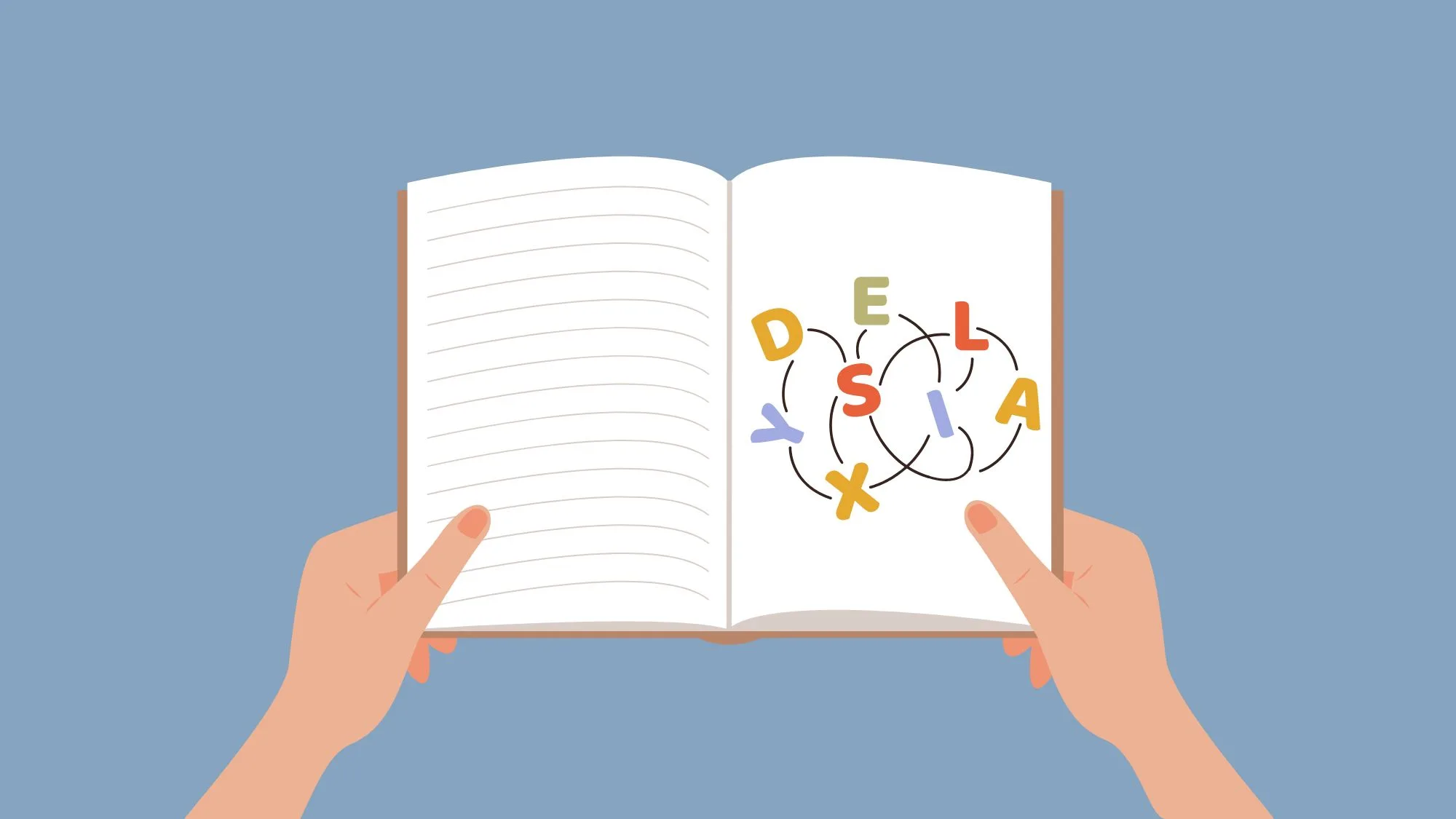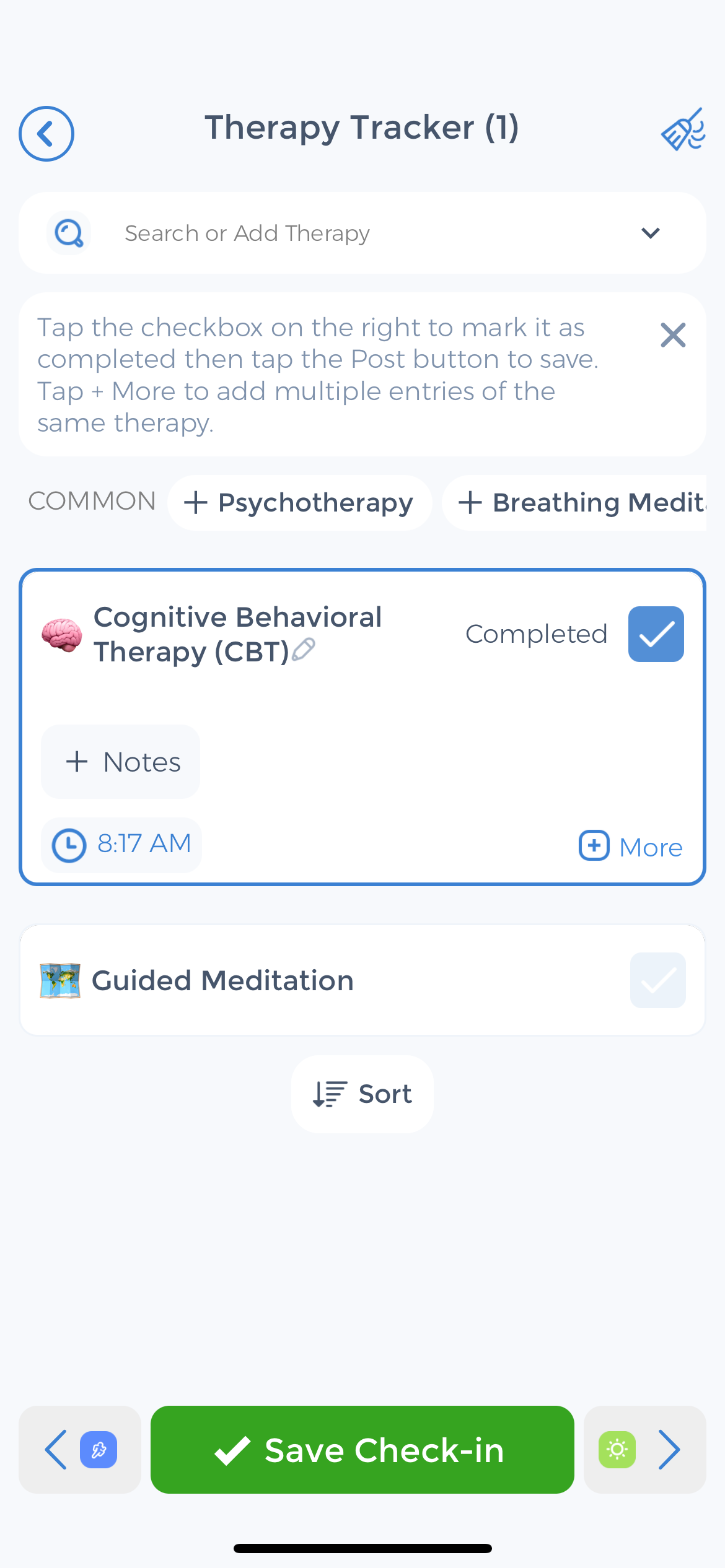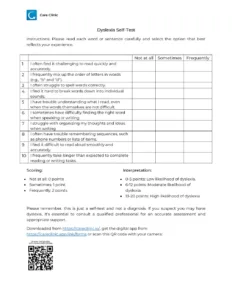
Are you struggling with reading and writing? Do you find it difficult to recognize and manipulate sounds in language? You may be at risk for dyslexia, a learning disorder that affects an estimated 5-10% of the population. For those who suspect they or someone they know may be struggling with dyslexia, the key to unlocking support and tailored interventions often lies in taking a dyslexia test.
In this blog post, we will discuss what dyslexia is and how it can impact an individual’s ability to learn. In the realm of education and cognitive development, dyslexia stands as a significant challenge for both individuals and educators alike.
Printable Dyslexia Test
This tool is designed to shed light on potential signs of dyslexia in your child. It’s critical to remember, that this test isn’t a definitive diagnosis tool. It serves as an insightful guide, offering an initial understanding of your child’s struggles with reading and language. Our self-assessment test acts as a compass, pointing you in the right direction, prompting further exploration, and perhaps, professional consultation.
While the test can indicate potential signs of dyslexia, it’s not a substitute for a professional evaluation which provides a more comprehensive assessment. This tool is a supportive starting point in your quest to understand, navigate, and manage dyslexia. So, let’s start this journey of discovery together. As you walk this path, remember to do so with patience, empathy, and a keen understanding of your child’s unique learning style.
⬇️ Printable Dyslexia Test PDF
Understanding Dyslexia: More Than Just Reading Difficulties
Dyslexia is commonly linked to difficulties in reading, but its impact goes beyond mere reading struggles. It influences how the brain processes symbols, creating obstacles not only in reading comprehension but also in spelling, writing, and at times, even speech.
Reading Woes Extend to Spelling and Writing
The challenges faced by individuals with dyslexia encompass not just reading but also extend to spelling and writing. These difficulties arise due to the brain’s unique way of processing graphic symbols, making it harder for individuals to master fundamental phonetics.
Phonetic Mastery: A Hurdle for Dyslexic Child and Student
Dyslexic children often encounter issues in grasping basic phonetics, such as connecting letters to their corresponding sounds. This hurdle in phonetic mastery contributes to the overall challenges they face in reading, spelling, and writing.
Intelligence Beyond Labels: Additional Information and Knowledge
It is crucial to emphasize that dyslexia is not indicative of a lack of intelligence or aptitude. Rather, it highlights a distinctive mode of information processing within the brain. Recognizing and appreciating this diversity is key to fostering a supportive environment for individuals with dyslexia.
Unlocking Potential Through Individualized Education
To empower dyslexic students, adopting an individualized approach to education is paramount. Tailoring strategies to their unique learning styles and providing targeted support can help unlock their potential and facilitate better academic outcomes.
Embracing Diversity for Creative Problem-Solving
In an inclusive atmosphere that embraces the diversity of information processing, dyslexic individuals can leverage their unique cognitive strengths for creative problem-solving. Encouraging this perspective not only benefits dyslexic students but also enriches the overall educational environment.
What Causes Dyslexia?
 The genesis of dyslexia lies in the unique way an individual’s brain is structured and functions, making it a neurobiological condition. Genetic factors often play a pivotal role, with studies showing that dyslexia tends to run in families. If a parent or sibling has dyslexia, the probability of the child being dyslexic increases. However, the exact genetic markers responsible have yet to be pinpointed. Furthermore, while heredity is a common thread, it’s not the sole influencer.
The genesis of dyslexia lies in the unique way an individual’s brain is structured and functions, making it a neurobiological condition. Genetic factors often play a pivotal role, with studies showing that dyslexia tends to run in families. If a parent or sibling has dyslexia, the probability of the child being dyslexic increases. However, the exact genetic markers responsible have yet to be pinpointed. Furthermore, while heredity is a common thread, it’s not the sole influencer.
Dyslexia can also be shaped by various environmental components. This can include early childhood experiences, exposure to language and reading in the initial years, and even prenatal factors. As we dive deeper into the causes of dyslexia, remember it’s a complex interplay of both genetic and environmental factors that shape this unique neurodiversity.
It’s crucial to appreciate the varied aspects involved and resist oversimplifying this intricate condition. This is not just about better understanding and awareness but also ensuring that the right support structures and learning interventions can be designed and implemented for those with dyslexia. Looking at the entire picture – genetic predispositions, environmental factors, and personal experiences – gives us a more comprehensive understanding of this multifaceted learning difference.
For instance, a child with a family history of dyslexia might still develop normally if provided a conducive early learning environment, whereas another child without any genetic predisposition might struggle with reading if exposed to stressful prenatal conditions. Each case of dyslexia thus presents its unique blend of factors, warranting a personalized approach to management.
Signs and Symptoms: How Dyslexia Manifests
Identifying dyslexia can be a complex task as its signs and symptoms can vary significantly from person to person. Commonly observed indicators often include challenges in spelling, difficulty in sounding out words, and a slower pace in reading. Writing can become an uphill battle and the comprehension of the written text can be compromised.
Looking back at early childhood, you might find instances of delayed speech development or hurdles in learning the alphabet, both of which could point toward a dyslexic tendency. It’s important to note that these symptoms don’t necessarily confirm the presence of dyslexia, but rather act as potential flags signaling that your child might benefit from further professional assessment. Always remember, your child is more than a list of symptoms or challenges.
Recognizing these signs is simply the first step towards providing them with the support and strategies they need to succeed. For instance, if your child struggles with reading aloud or constantly misspells words, it might be time to reach out to a learning specialist for guidance. Their professional input can help create a tailored learning plan, taking your child’s unique strengths and areas of difficulty into consideration.
The Importance of Early Diagnosis: Take the Dyslexia Test
Recognizing dyslexia at an early stage can profoundly influence a child’s educational path and personal growth. With an early diagnosis, educators and parents can develop and introduce teaching methods tailored specifically to a child’s unique learning style. This allows them to intervene at a time when the brain is still highly adaptable and receptive, making the learning strategies significantly more effective.
Early identification of dyslexia not only promotes academic success but also aids in nurturing a positive self-image in the child. It provides an opportunity to emphasize their strengths and instill confidence, thereby preventing feelings of frustration and inadequacy that may arise from unaddressed learning struggles. While dyslexia poses its own set of challenges, remember that with early diagnosis, appropriate intervention, and steadfast support, your child can effectively navigate these hurdles and thrive. The sooner we detect dyslexia, the earlier we can begin to enrich their learning journey.
The Impact of Dyslexia: It’s More than Just Academic
 Dyslexia’s influence extends far beyond classroom walls, with potential implications for a child’s emotional well-being and self-image. The recurring academic hurdles children with dyslexia often face can lead to feelings of frustration, alienation, or self-doubt. Their continuous effort to keep pace with their peers, who seemingly master reading with ease, can be emotionally taxing and challenging to their self-esteem.
Dyslexia’s influence extends far beyond classroom walls, with potential implications for a child’s emotional well-being and self-image. The recurring academic hurdles children with dyslexia often face can lead to feelings of frustration, alienation, or self-doubt. Their continuous effort to keep pace with their peers, who seemingly master reading with ease, can be emotionally taxing and challenging to their self-esteem.
However, it’s important to remember that while these struggles are real, they are not insurmountable. Through compassionate understanding, robust support systems, and the right strategies in place, children with dyslexia can not only overcome these challenges but also excel in their unique ways. Also, recognizing their non-academic strengths – whether that’s creativity, problem-solving, leadership, or empathy – can boost their self-confidence and resilience. Let’s remind our children that dyslexia doesn’t define their intelligence or potential; it merely reflects a different way their brain processes information.
As a learning difference, dyslexia often requires children to approach reading and learning differently, but it in no way measures their abilities or worth. Rather, it showcases their strength and tenacity to overcome difficulties in an education system primarily designed for conventional learning styles. Such perseverance in the face of adversity is admirable and a testament to their resolve and determination. It is crucial to recognize and celebrate this, amplifying the positive facets of dyslexia that often go unacknowledged.
Their value and capabilities extend far beyond their ability to read or spell. Indeed, embracing these unique attributes and skills, instead of conforming to conventional learning methods, may not only foster their academic growth but also their personal development. As such, we need to create learning environments that celebrate neurodiversity and cultivate an inclusive understanding of success.
Coping Strategies and Therapies: Navigating Dyslexia
Going through dyslexia might feel hard, but there are many ways to make it easier and succeed. Here are some simple ways to help:
Learning with Many Senses
One good way is to use different senses at the same time when learning. This means using our eyes, and ears, and even moving around while learning. This makes it easier to understand and remember things.
Getting Personal Attention with a Tutor
Having someone teach you one-on-one can be very helpful. This person, called a tutor, can pay special attention to you. They help you learn new things and overcome any problems you might have.
Using Technology for Support
In today’s world, we have many gadgets that can help with dyslexia. There are apps that read text out loud, tools to organize things better, and checks for spelling mistakes. Using these tools makes learning more inclusive and easier for everyone.
Speech Therapy to Improve Talking Skills
Speech therapy is another way to help with dyslexia. It helps with talking and pronouncing words better. This therapy is good for improving how we communicate. This therapy also helps child and adults to become aware of unfamiliar words as well as nonsense words that they may encounter in real world.
Strategies for Managing Dyslexia
After confirming a diagnosis, navigating dyslexia becomes a crucial endeavor. The goal is not to cure but to empower, with strategies tailored specifically for your child’s unique learning style. Be proactive in encouraging reading, and incorporate dyslexia-friendly resources into their study regime. Technology, as we’ve previously mentioned, can serve as a powerful ally in this journey. Use apps that convert text to speech, or help with organization and spelling.
At home, cultivate an environment that bolsters your child’s self-confidence and resilience. Recognize their non-academic strengths and emphasize them, fostering a robust self-image that transcends academic performance. Most importantly, practice empathy. Understanding their struggles and reassuring them of your unwavering support will make your child feel cherished and important, independent of their reading abilities.
Remember, your child is more than their dyslexia, and with the right strategies and a nurturing environment, they can not only manage but thrive. Continuing to advocate for their unique needs in the classroom will also contribute greatly to their success. Keep communication open with their educators, ensuring their understanding and implementation of dyslexia-friendly teaching methods.
Download the CareClinic App Today to Help Manage Dyslexia
Experience the ease of managing dyslexia with the CareClinic App. Whether you’re seeking to understand your symptoms better or tracking the effectiveness of different interventions, our app provides comprehensive tools to support your journey. With detailed reporting features, you can gain valuable insights into your progress over time, enabling you and your healthcare team to make informed decisions about your care.
Take control of your dyslexia management today by downloading the CareClinic App and start tracking your progress with confidence.



